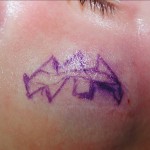
Despite the hype and marketing of many scar products and technologies, the reality is that scar excision remains the most effective treatment for many scar problems. Cutting out the scar and putting it back together is the most effective strategy for many scar problems. It is often not what patients want to hear and you can’t put it in a bottle and sell it on the internet. But more times than not, this is the really effective scar treatment strategy. Depending upon the scar type and its location (orientation), narrowing and geometric rearrangement are the best method for diminishing the scar’s appearance.
Geometric rearrangement of scars refers to changing the straight line of a scar to an irregular one. This is particularly advantageous if the scar violates the natural skin creases. (for example, a vertical scar on the forehead) Scars that run perpendicular or obliquely to these natural skin creases (otherwise known as RSTL, relaxed skin tension lines) are not only very visible to the eye but become more obvious with facial expressions as the natural wrinkles are noticeably distorted.
Scar line rearrangement can be done in a variety of geometric patterns known as z-plasty, running w-plasty, and a few other letters of the alphabet…..all which serve to break up a straight line and make it distort less with facial movements and wrinkling. Such scar techniques have been around for many decades and they are not new. They are tried and true techniques of plastic surgery. It is critical that the patient understand that the realistic objective is decreased scar appearance. There is no magic eraser that can make scars go away completely.
The biggest issue that any patient faces when considering scar excision and geometric rearrangment is that one must take a step back to eventually move forward. It is a committment of time and patience. The scar must be cut out and closed and go through many months of healing before the final result will be seen. As all scars go through a redness phase, this may mean up to a year to get to where you want to be. This process of scar maturation, however, is where some newer technologies such as pulsed light therapies may be beneficial. They are capable of making the scar mature and settle faster. Even if it is just a few months of shortening the process that would be considered a benefit by most patients.
Dr. Barry Eppley
Indianapolis, Indiana


